|
sito + "/AREA=" + sezione + "/AAMSZ=" + misura + "/ACC_RANDOM=" + bumber + "/PAGEID=" + pageid + "'>"); document.write(""); |
| home > allestimenti |
|
sito + "/AREA=" + sezione + "/AAMSZ=" + misura + "/ACC_RANDOM=" + bumber + "/PAGEID=" + pageid + "'>"); document.write(""); |
| home > allestimenti |
| Installing
Diller+Scofidio at the Whitney Alicia Imperiale |
||||
| The
Whitney Museum of American Art hosted, between March 1st and June 1st
2003, a significant restrospecive on the work of two among the most
provocative architects practicing today: Elizabeth Diller and Ricardo
Scofidio. Scanning: The Aberrant Architectures of Diller + Scofidio
is introduced, on the pages of ARCH'IT, through three presentations:
in "Installing Diller + Scofidio at the Whitney" Alicia Imperiale focuses
on the immersive and intense journey that D+S lay out for the visitors
of the exhibit; in "Display Engineers" Aaron
Betsky, co-curator of the show with K. Michael Hays, gives an insightful
investigation of D+S’s oeuvre; and finally there is a brief interview
to the architects conducted by Marco
Ligas Tosi. [PG] |
||||
|
Not merely a retrospective
of the varied oeuvre of architects Elizabeth Diller + Ricardo Scofidio
(D+S), the exhibit Scanning: The Aberrant Architecture of Diller+Scofidio
at the Whitney Museum of Art gives the architects the opportunity
to work performatively. The metaphor of the memory theater of Giulio
Camillo in the 1986 performance for which they designed the environment,
allows the architects to design the exhibit as a set of triggers for
memory and narrative. Memory theater as an aid to oratory invites
the speaker to "place" (constructed) complete thoughts in each of
a series of rooms of an imaginary house. In order to deliver a speech,
the orator need only "visit" the various rooms, in any sequence, in
order to release the full contents of that condensed thought, in diverse,
content rich narratives. |
[29ott2003] | |||
 Ricardo Scofidio and Elizabeth Diller, 2001. (Photo: Mark LaRosa) |
The D+S exhibit is set up as such -a trajectory through the space takes
one on a journey, an itinerary through a series of places and "non-places"
that come under the critical eye of the architects. D+S have been acutely
aware of the status of place and most especially of the non-places that
Marc Augé has described: the ubiquitousness and placelessness of the
utopic -the airport lounge, the suburban sprawl, and shopping malls-
all places that signify the "norms" of polite society and behavior that
border on the empty, vacuous space of contemporary life. These polite divisions of spaces are set up by rules -etiquette and behavior that are mirrored in the daily events and spaces that contain them. It should not come as a surprise that the iconic spaces of a museum exhibit are examined with an intense scrutiny by the D+S team. Gallery walls, reserved for the display of art, become the first site of intervention. The installation commissioned by the Whitney for the exhibit, Mural, 2003, breaks down the boundaries of the gallery wall in defining separate exhibit rooms. A track runs continuously through a series of exhibition spaces. A robotic drill is programmed to move randomly on this track drilling a series of 3/4" (2 cm circa.) holes in the gallery walls. A plexiglas box is attached to the bottom of the drill to catch the gypsum dust. In one room, black painted walls reveal the fine white dust that invariably falls, revealing, as had Ann Hamilton’s 1999 installation in the American Pavilion at the Venice Biennial, emergent patterns on the walls -as if a text in braille was revealed to the sighted. |
|||
 Vice/Virtue Glasses. Fountain, 1997. Blown glass with hypodermic needle, 4 x 2 7/8 x 2 7/8 in. (10.2 x 7.3 x 7.3 cm). Henry Urbach Architecture, New York.  Vice/Virtue Glasses. Dispensary, 1997. Blown glass with Prozac capsules, 4 x 2 7/8 x 2 7/8 in. (10.2 x 7.3 x 7.3 cm). Henry Urbach Architecture, New York. |
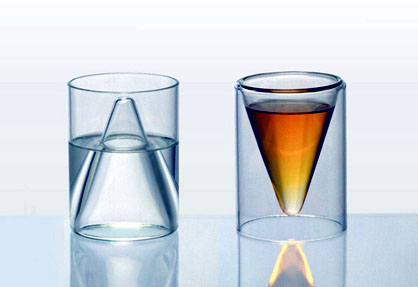 Vice/Virtue Glasses. Reservoir, 1997. Blown glass, 4 x 2 7/8 x 2 7/8 in. (10.2 x 7.3 x 7.3 cm) each. Henry Urbach Architecture, New York. As the drill continues through its autocatalytic set of perforations, eventually, left to its own devices (and ruefully past the duration of the exhibit) it would completely perforate either side of the walls, increasing the breakdown of barriers of one space to another -an intimation of the subversive nature of this piece in relation to the power structures of museum spectatorship. D+S act out within this theme. If the status of the wall as the organizer and index of visual arts is to be questioned, then the act of locating any of the objects, images, buildings and performances within the space of the museum, one would speculate, comes under intense scrutiny. D+S do not let us down in this regard. Video projections, large scale constructions and intricate apparati find themselves actively speaking and leading us through the space of the 4th floor of the Whitney, as the commedia dell’arte actors led the audience (myself included) in the vaults of the Brooklyn Bridge anchorage in the 1986 performance. All the works in the show are active, beckoning characters in the performance. |
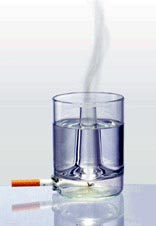 Vice/Virtue Glasses. Exhaust, 1997. Blown glass with cigarette, 4 5/16 x 3 3/16 x 3 3/16 in. (10.5 x 7.8 x 7.8 cm). Henry Urbach Architecture, New York. |
||
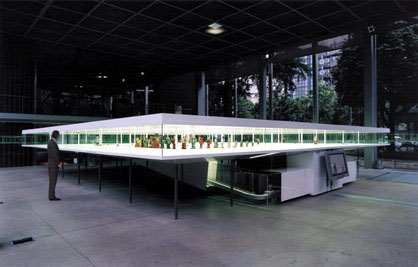 Master/Slave, 1999. Mixed media installation with toy robots from the collection of Rolf Fehlbaum, installation view, Fondation Cartier pour l'art contemporain, Paris. 6 x 36 x 36 feet, collection of Rolf Fehlbaum. (Photo: Michael Moran) As one enters the exhibit from the bank of room-sized elevators at the Whitney, one encounters an enormous video projection of a man "modeling" the white dress shirts that are a result of the process of bad pressing. [Bad Press: Dissident Housework Series, 1993-98]. This image both pushes you out and welcomes you in. At the time that I saw the show, my attention was divided between the video and the overwhelming noise of the drill at work to the left of the screen -the use of this device is the ultimate upstaging device- breaking down, subverting the good, polite practice of viewing art. We’re never left to rest at that point. |
||||
 Bad Press: Dissident Housework Series, 1993-1996. Custom ironed shirts, two single-channel videos. Dimensions variable. (Photo: Michael Moran) Drawn around the video screen, one sees a small, lit niche recessed within the back wall of the space (I was imagining that the drill is programmed to move around this niche??). This glass alternates from translucent to transparent with electrically charged particles. In the transparent state, one sees into an iron and in the translucent, one sees a text from a 1962 housekeeping guide as to how to iron a man’s white dress shirt perfectly. D+S take these instructions to task in having rewritten the rules for a "bad press." Turning back to the video, a low display case holds many of the resultant aberrant objects. |
||||
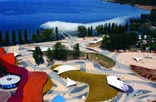 Blur Building, aerial view. Lake Neuchâtel, Yverdon-les-Bains, Switzerland, 2002. |
This
is an example of how D+S combine video, text and artifacts in a total
environment. If the first space explored large scale video displayed
vertically, the next room projects the video on the floor [Pageant,
1997] in which corporate logos morph from one to another in black text
on a white background. In this context, this piece seems to be critical
of the overarching influence of globalization. I believe that this is
the intent of the piece, but would like to note that the work is affected
by context. Installed (vertically projected) in the Italian Pavilion
of the 2000 Venice Biennial of Architecture, this work seemed to be
in a suspicious relationship with the long lists of corporate sponsors
who supported the production of various full-scale installations in
adjacent rooms and within the American Pavilion. |
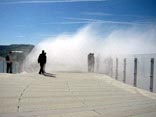 Blur Building, Angel Deck. Lake Neuchâtel, Yverdon-les-Bains, Switzerland, 2002.  Blur Building, view from shore. Lake Neuchâtel, Yverdon-les-Bains, Switzerland, 2002.  Blur Building, night view. Lake Neuchâtel, Yverdon-les-Bains, Switzerland, 2002. |
||
|
|
In all of their work, they walk the fine line between proper form and
criticality. It is essential to the project. Their installation [Tourisms:
Suitcase Studies, 1991] addresses these issues. This installation
is a traveling exhibit, esconced within 50 identical Samsonite suitcases.
These cases are opened like clamshells and hung, in alphabetical order
within the gallery space from a fabricated ceiling. In each suitcase
there is a "case study" of a tourist attraction in one of the 50 U.S.
states. These sites are either a famous battlefield, or the bedroom
of a well-known American personage. The cases use images, text, small
models of either battle-related toys, or toy furniture. The use of mirrors
reflects the objects and images and brings diverse objects in relation
to each other. The suitcases are arranged 5 across by 10 deep in the
space and are connected to the state’s location on the map of the U.S.
that is hidden on the upper surface of the ceiling. The piece is impressive
as it is hung in the space. The line of the hinge of the Samsonite case
is hung at eyelevel, striking a horizon line through the space that
fully unifies the diverse cases. Each suitcase is constructed as an
elaborate diorama and brings to mind classification and display systems
employed in a natural history museum.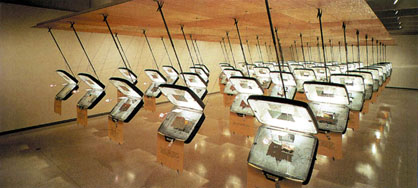 Tourisms: suitCase Studies, 1991. Mixed-media installation with 50 suitcases and fabricated ceiling, 10 x 60 x 30 feet. Installation view, Walker Art Center, Minneapolis (Photo: Glenn Halvorson) While the installation can be appreciated simply for its formal and spatial aspects, it is helpful to read the accompanying text to understand more fully the subtle and far-reaching sets of allusions that are embedded within the work. |
|||
 Computer rendering of Institute of Contemporary Art, Boston, harbor view, 2002. (Courtesy of Diller+Scofidio) The work can border between the didactic material in a museum (the diorama – pointing to another reality) rather than it fully being it as it is. One feels the necessity to "read" the wall text to fully "read" the work. I would say that there is a "correct" way that D+S would like us to "read" into each piece rather than opening each up to a viewer’s interpretation. I would like to be able to misread their work a bit more and not feel like I’ve missed their point... |
 Computer rendering of Institute of Contemporary Art, Boston, southwest view, 2002. (Courtesy of Diller+Scofidio) |
|||
 Computer rendering of Eyebeam Museum of Art and Technology, southeast view, 2001. (Courtesy of Diller+Scofidio) 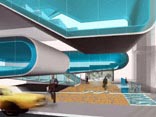 Computer rendering of Eyebeam Museum of Art and Technology, lobby, 2001. (Courtesy of Diller+Scofidio) |
 Computer rendering of Eyebeam Museum of Art and Technology, southwest view, 2001. (Courtesy of Diller+Scofidio) In that way, while immersive and intense, their work is also well viewed in a book, where artifact and text are side-by-side and maintain equal status. It is an issue that I imagine will be resolved, addressed and invited in their built architecture as an extension of their critical and performative practice. It asks us to address their work as lived virtually -read with the body- not just seen (as so much of their work has to do with the optical model). This would call for an interpretation of Walter Benjamin in that architecture is a unique practice wherein architecture is seen optically and felt haptically. D+S intuit and practice this question in series of performances. It affects their working in a museum as an installation where the real and the fabricated slip from one to the other. Is it that the museum work at the Whitney is merely a simulacrum? No! because the sequence of installations at the Whitney provide a cogent critique on museum spectatorship and the status of the "art" object as explored through the simultaneous deployment of architectural display, projection, objects, artifacts, performance, models and text. |
|||
 Interclone Hotel, Ho Chi Minh City, 1997. Slide projection, dimensions variable. One is invited to think through seeing and touch, through reading in a synaesthetic mix, inviting mind and body, vision and touch, together in that slippery zone between the real and imaginary. They both share equal status in the work of Diller + Scofidio. Alicia Imperiale aliciaimperiale@hotmail.com |
||||
|
List of the works
in exhibit, counterclockwise from entrance, looping around the 4th
floor of the Whitney: |
||||
|
>
BETSKY: DISPLAY ENGINEERS |
||||
|
La
sezione Allestimenti laboratorio
|